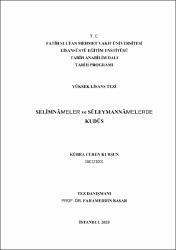| dc.contributor.advisor | BAŞAR, Fahameddin | |
| dc.contributor.author | KURŞUN, Kübra Ceren | |
| dc.date.accessioned | 2019-04-04T06:57:08Z | |
| dc.date.available | 2019-04-04T06:57:08Z | |
| dc.date.issued | 2019 | |
| dc.date.submitted | 2019 | |
| dc.identifier.citation | KURŞUN, Kübra Ceren, Selimnâmeler ve Süleymannâmelerde Kudüs, Fatih Sultan Mehmet Vakıf Üniversitesi Lisansüstü Eğitim Enstitüsü Tarih Anabilim Dalı, Yayımlanmamış Yüksek Lisans Tezi, İstanbul 2019 | en_US |
| dc.identifier.uri | https://hdl.handle.net/11352/2844 | |
| dc.description.abstract | XVI. yüzyıl, Osmanlı Devleti için doğu ve batıda sınırlarını iyice genişlettiği bir dönemi ifade eder. Bu genişleme, Arap topraklarının Osmanlı hakimiyetine girmesiyle başka bir hüviyete bürünmüştür. Medine, Mekke, Kudüs gibi İslam dünyası için önemi tartışılmaz olan şehirler Yavuz Sultan Selim’in Suriye ve Mısır Seferi sonucunda Osmanlı toprağı halini almıştır. Üç semavi din için kutsal şehirlerden olan Kudüs de Osmanlı Devleti’nin sınırları içerisine bu sefer sırasında dahil olmuştur. Yavuz Sultan Selim’in kısa süren saltanatında, Osmanlı Devleti adına çok fazla yatırıma rastlanmasa da Kanuni Sultan Süleyman dönemi, pek çok şehir gibi Kudüs’ün de ihya olduğu bir dönemi ifade eder. Bu dönemde Kudüs’teki imar faaliyetleri, hayır kurumlarının tesisi, Kanuni Sultan Süleyman’a, şehri ilk imar eden Hz. Süleyman Peygamber’e ithafla II. Süleyman benzetmesinin yapılmasına sebep olmuştur.
Bu tezde, Osmanlı Devleti’nin Kudüs’teki varlığının dönem kaynaklarında nasıl geçtiği incelenmiştir. Osmanlı dönemi Kudüs’ü için önemli bir yere sahip olan Yavuz Sultan Selim ve Kanuni Sultan Süleyman devirleri, XV. ve XVI. yüzyıl kaynakları genelinde, Selimnâme ve Süleymannâmeler özelinde incelenmiş, kaynaklar üzerinden dönemin Kudüs algısı analiz edilmeye çalışılmıştır. | en_US |
| dc.description.abstract | The 16th century reflects a period when the Ottoman Empire expanded its borders in both East and West. This expansion gained another identity when the Ottomans began to rule the Arab Lands. Medina, Mecca and Jerusalem which are cities whose importance is unquestionable for the Islamic World became an Ottoman land as a result of the campaign in Egypt and Syria of Yavuz Sultan Selim. Jerusalem, one of the holy sites of the Abrahamic religions, was taken over by the Ottoman Empire during this campaign. There was not a big investments for Jerusalem during the short reign of Yavuz Sultan Selim but the reign of Sulaiman the Magnificent was a period when Jerusalem was revived like many other cities. The establishment of charities, foundations and new construction activities in Jerusalem during this period caused Suleiman the Magnificent to be likened to Prophet Solomon who has considered the city for the first time and considered as the second Solomon.
In this thesis the existence of the Ottoman Empire in Jerusalem is studied according to sources of the period. The reigns of Yavuz Sultan Selim and Sulaiman the Magnificent which are very important for the Ottoman period of Jerusalem are examined in general of 15th and 16th-century sources and in particular of Selimnames and Süleymannames and the perception of Jerusalem of the period was tried to be analyzed through sources. | en_US |
| dc.language.iso | tur | en_US |
| dc.publisher | Fatih Sultan Mehmet Vakıf Üniversitesi, Lisansüstü Eğitim Enstitüsü | en_US |
| dc.rights | info:eu-repo/semantics/openAccess | en_US |
| dc.subject | Kudüs | en_US |
| dc.subject | Selimname | en_US |
| dc.subject | Süleymanname | en_US |
| dc.subject | Yavuz Sultan Selim | en_US |
| dc.subject | Kanuni Sultan Süleyman | en_US |
| dc.subject | Jerusalem | en_US |
| dc.subject | Selimname | en_US |
| dc.subject | Süleymanname | en_US |
| dc.subject | Sultan Selim I | en_US |
| dc.subject | Suleiman the Magnificent | en_US |
| dc.title | Selimnâmeler ve Süleymannâmelerde Kudüs | en_US |
| dc.title.alternative | Jerusalem the books of Selimname's and Süleymanname's | en_US |
| dc.type | masterThesis | en_US |
| dc.contributor.department | FSM Vakıf Üniversitesi | en_US |
| dc.relation.publicationcategory | Tez | en_US |
| dc.contributor.institutionauthor | KURŞUN, Kübra Ceren | |



















